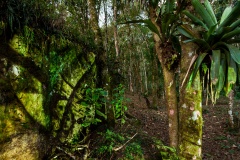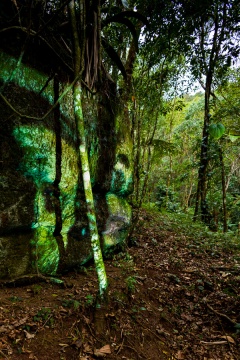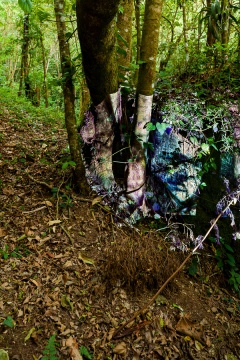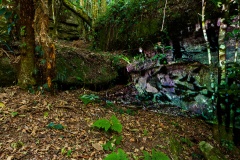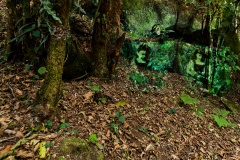A series of photographs of natural environment hides from the inattentive gaze the presence of scenes and bodies projected on the foliage. Several old photographs of Pedro’s family, material discovered by the artist after his grandmother’s death, were digitized and projected on his father’s body. The skin, hair and pores illuminated by the glittering images coming from the past, were closely photographed, generating renewed images, ready to be projected again, this time, on a natural landscape. During the day, traversing an environment of forest, rivers and rocks, Pedro has captured the moments in which these images were discreetly revealed on the texture of earth precipices and the tree canopies, creating scenes in which memories and events of nature mingle. In a phantasmagoria of images made of light, skin, light again, and then, surface of the world, there are indexes of a memory that can be mistaken for ghosts of space. We come across a place that is difficult to identify, where it is almost impossible for us to situate and meet with - we are lost amid this forest of memories.
In this Safari series, Pedro deals with photographs of his family's past, presenting the stories and characters that inhabit the artist's family heritage. It is a material of indirect memory, made in the 50s and 60s in Italy. They are people and places with whom Peter has "never" had contact. While facing that past, he also confronts a natural landscape where the passage of time and the very space perception are different from the spaces, surfaces and architectural compositions recurring in his previous works. This approximation between the old photographs and the natural landscape is curious, two fields that may seem distant, from different times and genesis. However, these two elements have a certain link for Pedro. Some of his previous works already sought a closer relationship between body and urban landscapes. Moreover, it is a recurring interest of the artist to deal with the passage of time in different spaces - while in urban landscape deterioration can be circumvented by a process of restoration and renewal, the aging body is visible and will always be marked, no matter how much one tries to avoid it. For this subtle difference, Pedro has identified, in nature, an aging process closer to the body, and more distant from urban landscape.
Safari is an intervention that emulates particular cases of transformation of nature into a livable space by man. A mixture of still life and portrait, the series has recombined the ways we think about photography, landscape, record and memory.
Paulo Miyada
